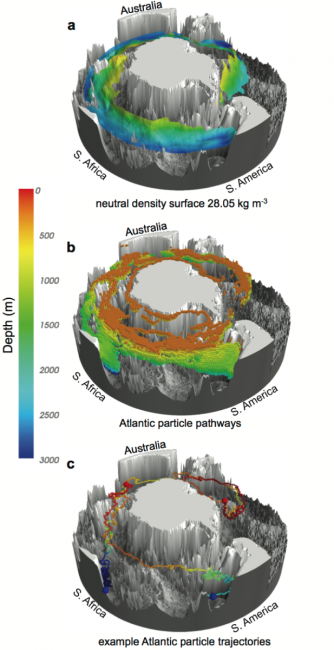Three-dimensional Southern Ocean upwelling pathways
Despite covering only 30% of the global ocean area, the Southern Ocean absorbs nearly half of the total carbon dioxide and 75% of the total heat absorbed by the oceans from the atmosphere. By absorbing excess heat and carbon dioxide, the Southern Ocean is damping the effect of global warming. The stability of the future climate depends on the Southern Ocean’s capacity to continue to suck heat out of the atmosphere.

One key reason the Southern Ocean plays such an important role in climate is due to its ability to upwell cold, carbon- and nutrient-rich deep water. Strong winds blowing over the Southern Ocean pull cold, deep water from the ocean abyss to the sea surface, forming a connection between the deep ocean and the atmosphere. Despite the importance of the Southern Ocean upwelling in regulating the climate, the three-dimensional pathways of this upwelling are largely unknown. A new study in Nature Communications combines ocean observations with three state-of-the-art ocean models, revealing the full three-dimensional pathway of deep water to the surface of the Southern Ocean for the first time.
A team of researchers tracked upwelling by releasing virtual floats in the deep ocean in three models, tracking the path they follow to the surface of the Southern Ocean, and compared this to hydrographic observations. It was previously thought that deep water upwelled to the ocean surface broadly all the way around Antarctica. This new study shows that deep water is carried to the Southern Ocean in deep, narrow currents, which meet in the Antarctic Circumpolar Current. Most of the deep currents were already well known, but a new pathway was identified carrying deep water from the Indian Ocean to the Southern Ocean along the southern coast of Australia. The deep water spirals southward toward Antarctica and up to the surface with the help of topographic obstacles: undersea ridges and mountains that create hotspots of swirling eddies, which push water southward and up toward the surface. There are five of these major upwelling hotspots associated with large undersea topographic features, which are responsible for most of the upwelling in the Southern Ocean.
These results have identified critical regions for upwelling of deep water, which should be targeted with future research expeditions. The researchers have also shown how the role of ocean eddy hotspots can create chimneys connecting the deep ocean with the surface, where the ocean interacts directly with the atmosphere. Three-dimensional modeling of ocean circulation and eddy hotspots is crucial for understanding the ocean’s ability to absorb heat and carbon dioxide from the atmosphere.
Spiraling pathways of global deep waters to the surface of the Southern Ocean (Nature Communications)
1Scripps Institution of Oceanography
2Princeton University
3NOAA Geophysical Fluid Dynamics Laboratory
4Jet Propulsion Laboratory, California Institute of Technology
5Los Alamos National Laboratory
6Australian National University
Topics
- Southern Ocean
- Ocean Heat
- Modeling
- Atlantic Ocean
- Carbon
